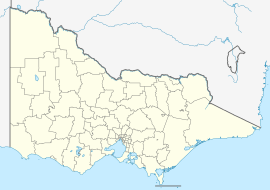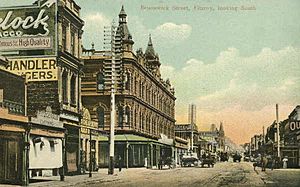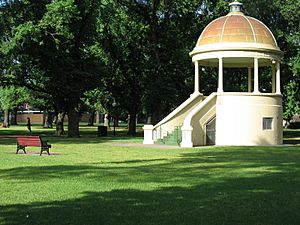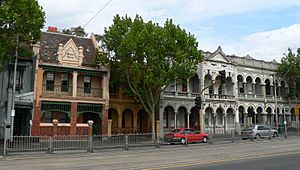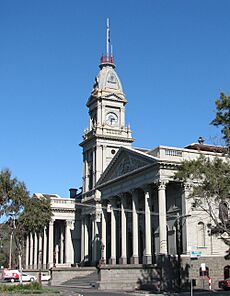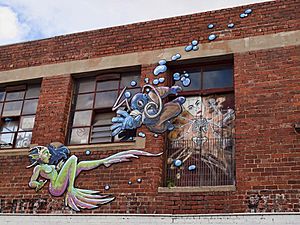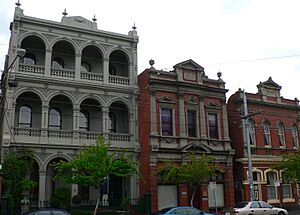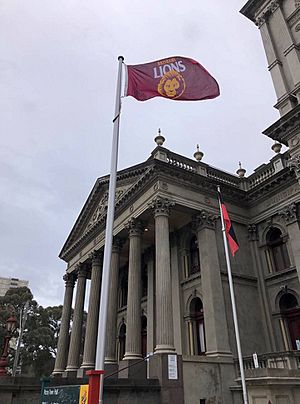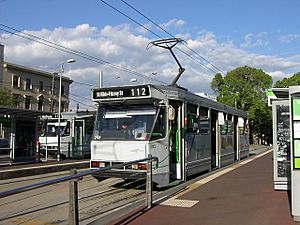Fitzroy, Victoria facts for kids
Quick facts for kids FitzroyMelbourne, Victoria |
|||||||||||||||
|---|---|---|---|---|---|---|---|---|---|---|---|---|---|---|---|
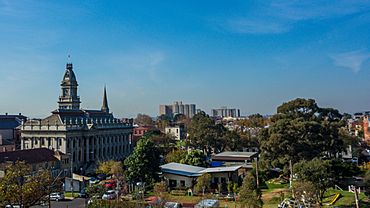
The Fitzroy skyline, with the Fitzroy Town Hall visible on the far left
|
|||||||||||||||
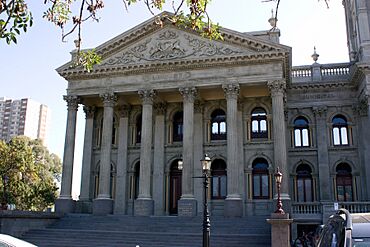
Fitzroy Town Hall
|
|||||||||||||||
| Established | 1839 | ||||||||||||||
| Postcode(s) | 3065 | ||||||||||||||
| Elevation | 35 m (115 ft) | ||||||||||||||
| Area | 1.4 km2 (0.5 sq mi) | ||||||||||||||
| Location | 3 km (2 mi) from Melbourne CBD | ||||||||||||||
| LGA(s) | City of Yarra | ||||||||||||||
| State electorate(s) | Richmond | ||||||||||||||
| Federal Division(s) | Melbourne | ||||||||||||||
|
|||||||||||||||
Fitzroy is a lively inner-city suburb in Melbourne, Victoria, Australia. It's about 3 kilometres (1.9 miles) north-east of Melbourne's city centre. Fitzroy is part of the City of Yarra local government area. In 2021, about 10,431 people lived there.
Fitzroy was planned in 1839 as Melbourne's very first suburb. It became one of the city's first independent towns in 1858. Fitzroy is Melbourne's smallest and most crowded area outside the main city. It covers only 100 hectares.
This suburb is known as a cultural hotspot. It's famous for its live music and amazing street art. It's also the main home of the Melbourne Fringe Festival. The main shopping and food street is Brunswick Street. This street is full of shops, restaurants, and nightlife. Fitzroy used to be a working-class area. But since the 1980s, it has changed a lot. This process, called gentrification, means that wealthier people have moved in. Now, Fitzroy has a mix of people from different backgrounds. It has some of the most expensive rents in Melbourne. It also has one of the largest public housing areas, called Atherton Gardens.
Fitzroy has many different types of buildings. You can see some beautiful examples of Victorian era architecture here. Much of the suburb is protected for its history. Many buildings and streets are kept safe by special rules. Fitzroy was named after Sir Charles Augustus FitzRoy. He was the Governor of New South Wales from 1846 to 1855. Fitzroy is surrounded by major streets. These include Alexandra Parade (north), Victoria Parade (south), Smith Street (east), and Nicholson Street (west).
Contents
History of Fitzroy
Fitzroy was Melbourne's first planned suburb. It was created in 1839. Back then, the land was divided into blocks and sold. This area was first called Newtown.
Later, Newtown was renamed Collingwood. The area we now call Fitzroy became part of the Melbourne City Council. But on September 9, 1858, Fitzroy became its own town. It was separate from Melbourne. The first local council election happened soon after.
Fitzroy was close to many factories and industrial places. This made it a good place for working people to live. From the 1860s to the 1880s, many working-class families moved to Fitzroy. The big old houses became boarding houses or crowded homes. Because of the poverty, many charities and religious groups started helping people. A famous local businessman was Macpherson Robertson. His candy factories took up several blocks. Today, these buildings are important historical landmarks.
After World War II, many people from Italy and Greece moved to Fitzroy. This changed the area's culture. The government also built new public housing in the 1960s. These included the Atherton Gardens towers.
Fitzroy has always been a diverse place. After World War I, many Chinese immigrants settled here. This was because it was close to Chinatown. Today, there are also Vietnamese and African communities. Johnston Street is a centre for Melbourne's Hispanic community. You can find many Spanish and Latin American restaurants and shops there.
In the 1980s and 1990s, Fitzroy changed again. Old factories became apartments. Rents went up, and some long-time residents moved to other suburbs. In 1994, the City of Yarra was formed. It combined Fitzroy with the nearby towns of Collingwood and Richmond.
Fitzroy's Landscape
Fitzroy is a flat area. Its streets are laid out in a grid plan. Many streets are narrow and only allow one-way traffic. The buildings are a mix of old and new. This is because different types of buildings were allowed to grow close together over time. This gives Fitzroy a unique look.
People of Fitzroy
In the 2021 census, Fitzroy had 10,431 people. About 60% of them were born in Australia. However, many residents (41.4%) had parents who were born overseas. The most common countries of birth for residents were England, Vietnam, New Zealand, China, and the United States.
In 2016, the average age in Fitzroy was 33, which is younger than the national average. The average weekly income was higher than the national average. Only about a quarter of Fitzroy's population was married.
Homes in Fitzroy
Fitzroy has many different types of homes. You can find some of Melbourne's oldest houses here. There are also many terraced houses. These are rows of similar houses joined together. You'll also see old factories turned into apartments, and modern apartment buildings.
Royal Terrace on Nicholson Street is one of the oldest homes. It was built between 1853 and 1858. These historic homes are now very popular and expensive.
In the 1960s, the Housing Commission of Victoria built large public housing estates. One of the biggest is Atherton Gardens. It's located at the corner of Brunswick and Gertrude streets. These estates were built to replace older, crowded homes.
Because Fitzroy is such a popular place to live, new homes are always being built. These new buildings often try to fit in with Fitzroy's unique style.
How Fitzroy is Governed
Fitzroy has a history of supporting left-wing politics. This means people often vote for parties that focus on social fairness and community. The Australian Labor Party and the Australian Greens are very strong here.
Locally, Fitzroy is part of the City of Yarra. At the state level, it's in the Richmond area. At the federal level, it's in the Division of Melbourne.
Fitzroy Town Hall
Fitzroy used to be its own town with its own council. The Fitzroy Town Hall on Napier Street was where the council met. This building is very important for its history and architecture. It was built in stages between 1863 and 1890. It included offices, a meeting hall, a police station, a courthouse, and a clock tower.
In 1994, Fitzroy joined with Collingwood and Richmond to form the City of Yarra. Now, the Fitzroy Town Hall is used for other offices and community services.
Culture in Fitzroy
Art Scene
Fitzroy is full of small art galleries and artist studios. It has a lively street art community. You can also find important art centres here. These include Gertrude Contemporary Art Spaces and the Centre for Contemporary Photography.
Live Music and Performance
Fitzroy is a major centre for live music in Melbourne. Many famous bands started here. Today, it has several popular music venues. These include The Old Bar, Bar Open, and the Evelyn Hotel.
Historic Buildings
Fitzroy has many beautiful old buildings. The Moran and Cato warehouse is known for its great design. The Champion Hotel is famous for its grand and fancy style.
Many buildings and sites in Fitzroy are protected for their history. These include:
- The Aqua Profonda sign at Fitzroy Swimming Pool.
- The Cordial Factory on Argyle Street.
- The National School on Bell Street.
- Dodgshun House and The Terrace on Brunswick Street.
- The Fitzroy Cricket Club Grandstand in Edinburgh Gardens.
- The Devonshire Arms Hotel on Fitzroy Street.
- The Christian Israelite Sanctuary on Fitzroy Street.
- St Mark's Church of England on George Street.
- Glass Terrace on Gertrude Street.
- Holyrood Terrace and Cobden Terrace on Gore Street.
- The Fitzroy Town Hall on Napier Street.
- Royal Terrace on Nicholson Street.
- The Union Bank of Australia on Smith Street.
- The Eastern Hill Hotel on Victoria Parade.
Pubs and Cafés
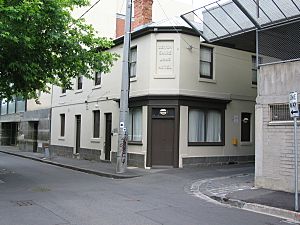
Fitzroy has many pubs for its size. The old Devonshire Arms hotel is the oldest building still standing in Fitzroy.
The suburb also has many cafés. Marios is one of the oldest cafés still open. As Fitzroy has changed, many new and stylish cafés have opened on Brunswick Street, Smith Street, and Gertrude Street.
Markets
On weekends, Fitzroy hosts several artisan markets. These include the Fitzroy Market and the Rose Street Artists' Market. Here you can find unique handmade items.
Sports in Fitzroy
The Fitzroy Football Club was formed in 1883. This Australian rules football club played in the top league for many years. Their main home ground was Brunswick Street Oval until 1966.
The club faced money problems in the 1980s. In 1996, it joined with the Brisbane Bears to form the Brisbane Lions. The Brisbane Lions kept parts of Fitzroy's history, like their logo and song. They also took eight Fitzroy players.
The Brisbane Lions went on to win three championships in a row (2001, 2002, 2003). They are considered one of the best teams ever. The club still has strong ties to Fitzroy.
After the merger, the Fitzroy Football Club started playing again in 2009. They play in the Victorian Amateur Football Association at Brunswick Street Oval.
Other sports clubs in Fitzroy include:
- The Fitzroy Stars Football Club (Indigenous Australian rules football).
- Heidelberg United (soccer), which was once based in Fitzroy.
- Fitzroy City Serbia Soccer Club (soccer).
- The Fitzroy Baseball Club, known as the Fitzroy Lions.
- The Melbourne Chess Club, the oldest chess club in the southern hemisphere (started in 1866).
Community Services
St Vincent's Hospital helps with the health needs of people in Fitzroy and Melbourne.
There are two primary schools in Fitzroy: Fitzroy Primary School (government) and Sacred Heart Primary School (Catholic). Fitzroy High School is located nearby in Fitzroy North. In 2021, a teacher from Sacred Heart School won the Music Teacher of the Year award.
Fitzroy has a long history of community support. Many groups help people here. These include the Fitzroy Legal Service, the Society of Saint Vincent de Paul, and the Brotherhood of St Laurence.
Getting Around Fitzroy
Fitzroy's main roads are Brunswick Street (north-south) and Johnston Street (east-west). Other important roads include Victoria Parade, Nicholson Street, Smith Street, and Alexandra Parade. Many narrow streets are one-way. Traffic and parking can be difficult.
There are no train stations directly in Fitzroy. The closest ones are in nearby suburbs. There are, however, three tram lines that go through or around Fitzroy:
- Route 86: travels along Nicholson Street, Gertrude Street, and Smith Street.
- Route 96: travels along Nicholson Street.
- Route 11: travels along Brunswick Street.
The St Vincents Plaza tram stop is just outside Fitzroy. It's a major interchange for several tram routes.
Cycling is very popular in Fitzroy. There are also car-sharing services available.
Fitzroy in Pop Culture
The 2010 Australian TV show Offspring was set mostly in Fitzroy. The characters often visited the Black Cat, a bar on Brunswick Street. Fitzroy has also appeared in other Australian TV shows.
Australian musicians often mention Fitzroy in their songs. Clare Bowditch and The Bedroom Philosopher have sung about it. American rapper Tyler, The Creator mentioned skating to Fitzroy. Most famously, ARIA award winner Dan Sultan has a song called "Old Fitzroy." Its music video was filmed entirely in Fitzroy.
Notable People from Fitzroy
Many famous people have come from Fitzroy, including:
- Harris Andrews (born 1996) – Australian rules footballer.
- Tony Birch (born 1957) – author and activist.
- Alfred Deakin (1856–1919) – second Prime Minister of Australia.
- Florrie Forde (1875–1940) – popular singer.
- Neil Harvey (born 1928) – famous Test cricketer.
- Mary MacKillop (1842–1909) – a Roman Catholic nun and the only Australian saint, born on Brunswick Street.
- Bert Newton (1938–2021) – famous television personality.
- Sir Doug Nicholls (1906–1988) – Aboriginal activist and sportsman.
- Archie Roach (1956–2022) – musician.
- Ben Simmons (born 1996) – NBA basketball player.
- Alma Thorpe (born 1935) – an Aboriginal elder.


